Drop us a short note with your inquiry by filling out the contact us form.
This "how-to-connect" documentation will explain the initial configuration of an example connection from Twitter to a SharePoint Online List in Office 365. We will be synchronizing data stored in Twitter.
This guide presupposes that you have installed the Layer2 Cloud Connector and that you are familiar with its basic functionality. The Layer2 Cloud Connector User Documentation will provide you with all necessary information.
2. Configuring the Layer2 Cloud Connector
2.2 Configuring the Data Entity 1
2.3 Configuring the Data Entity 2
3.4 Backend service and authentication
3.5 Connection forcibly closed
You can just pass the connection String "InitiateOAuth=GETANDREFRESH;" as your Twitter source connection String. In this case, go to the next point.
You can also create your own app. Go to your Twitter developer account and create a new app.
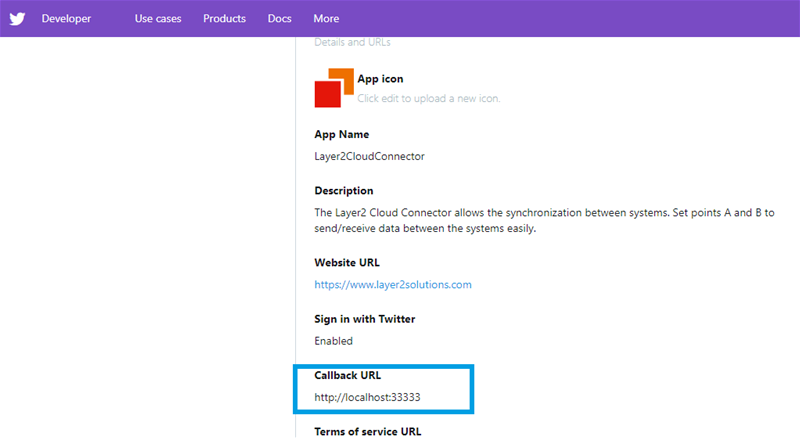
Set your callback URL and copy this value.
After creating your app, you will be able to get the client id and the client secret. Copy these values too.
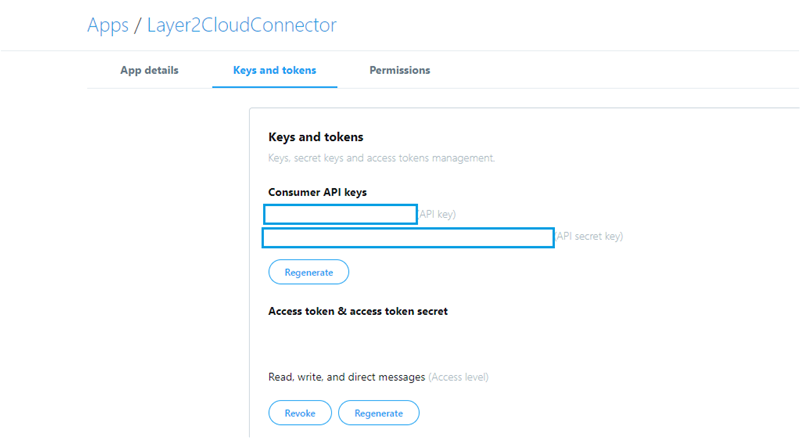
Create a new connection by using the Create New Connection option in the Actions pane (right-hand side). The new connection will appear at the bottom of the Connection Manager List (left-hand side). Click on your newly created connection to open the connection configuration settings.
Choose a meaningful name for your connection and replace the current "New Connection" Connection Title with it.
Connections to Twitter are read-only connections. We will choose Left to Right as Synchronization Direction. An initial connection should always be uni-directional to assure that both data entities are identical. Therefore, choose Left to Right as Direction.
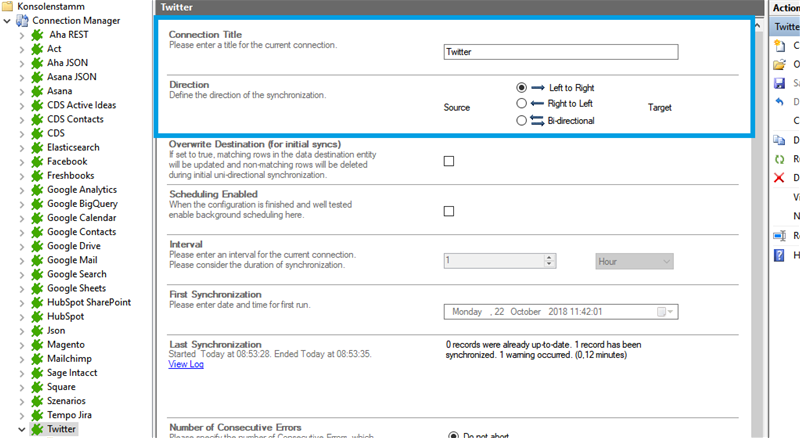
We will now set up our Data Entities. Go to the data entity “Data Entity 1” to open the configuration settings.
Choose a Data Entity Title. It is recommended to give your entities meaningful names to maintain an overview when you decide to set up multiple connections.
Select the Data Provider for Twitter from the data provider list. You can search for Twitter by typing into the selection box.

For the Connection String, we need the information mentioned in step 1. If you create your own app, you are going to need the information below. If you do not, just use InitiateOAuth="GETANDREFRESH".
You can copy the below connection string and adjust it to match your gathered information. Use the Verify Connection String option to evaluate if the provided connection string is valid.
OAuthClientID=yourclientid;OAuthClientSecret=yourclientsecret;CallbackURL=yourcallbackurl;InitiateOAuth=GETANDREFRESH;
The Select Statement text box is used to define specific data queries. We will be gathering the first tweet from our JSON response. You can copy the below select statement and adjust it to match your needs. Save your changes by using the right-hand pane option Save Changes.
SELECT TOP 1 * FROM Tweets
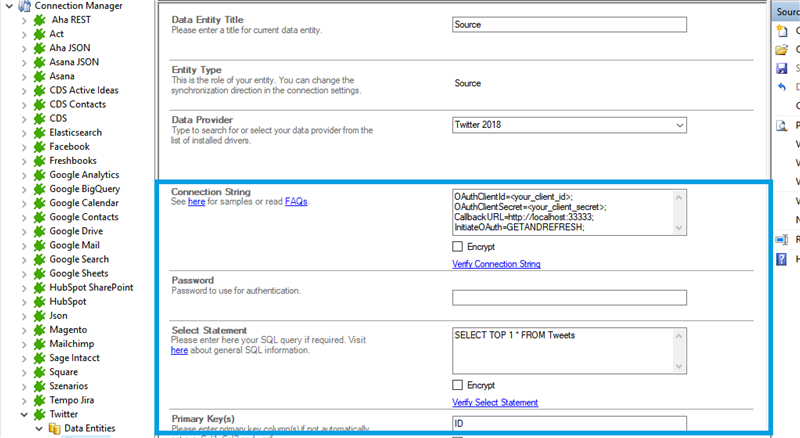
To check if all necessary columns are received, you can use the Preview Data option on the right-hand pane which will provide you with a pop-up window showing your sample data from your Twitter entity.
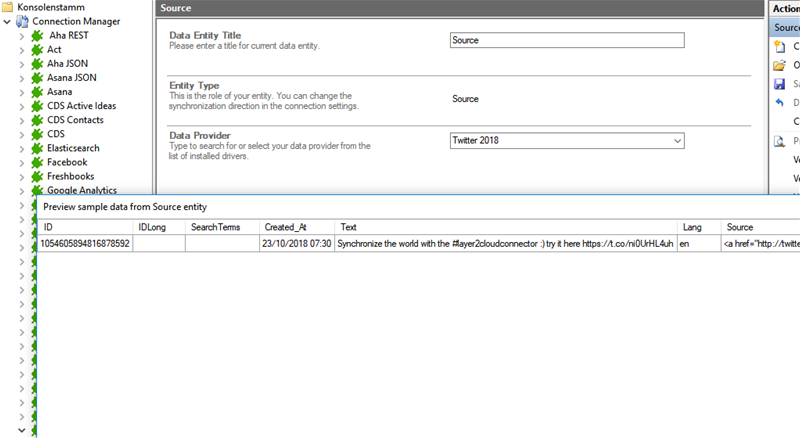
We are going to send the data to a custom SharePoint Online list. It's required that you set up this list prior to the next steps. Your list should contain matching columns according to your source entity.
Use the left-hand pane to switch to the data entity "Data Entity 2". We will be using the Layer2 SharePoint Provider for this setup.
For more information about the SharePoint provider visit:
https://www.layer2solutions.com/support/cloud-connector-faqs/layer2-csom-sharepoint-ado-net-provider.
You can copy the below Connection String which contains the minimum of required properties to connect to your custom SharePoint Online list.
URL=https://your_custom_sharepoint_list_url/AllItems.aspx;Authentication=Mirosoft_Modern;
Save your changes by using the right-hand pane option Save Changes.
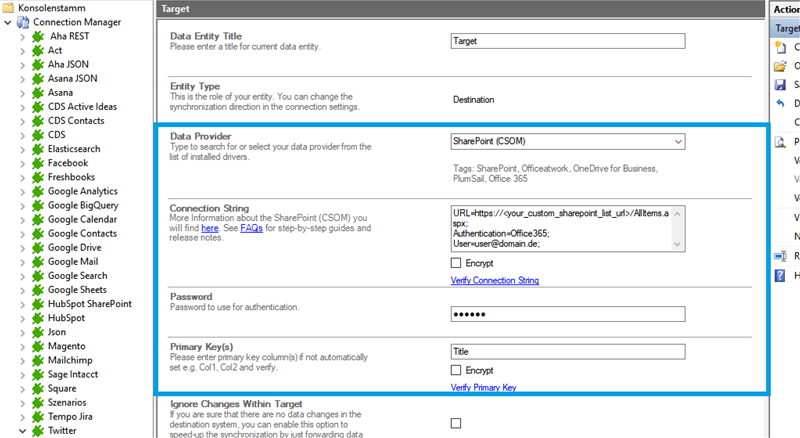
In the next step, we will configure our mapping settings. Click on the Mappings option on the left-hand pane. If your fields from SharePoint are named identical to the fields from your source system, the Enable Auto Mapping option will match those columns. Disabling this option allows you to match your columns as needed. We enabled auto-mapping in our setup. Save your changes by using the right-hand pane option Save Changes.
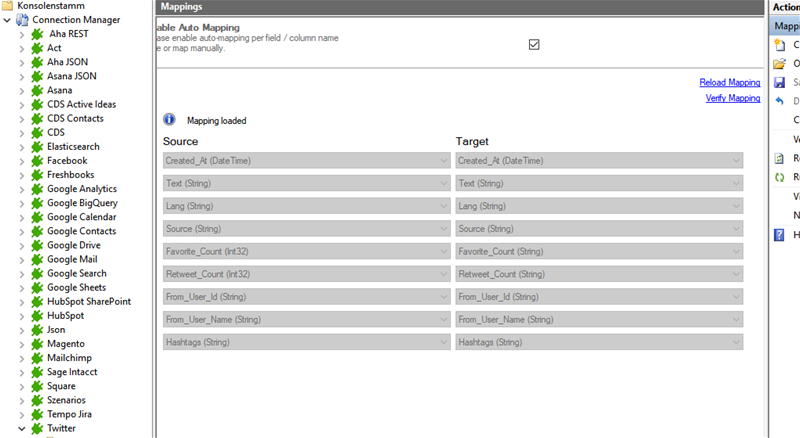
To run your connection switch back to the main connection configuration node and use the Run Now Button located on the bottom of the setup page. The Run Synchronization Toolbox will also display the synchronization process.

Below is a data preview of the information we have accessed in our source entity:
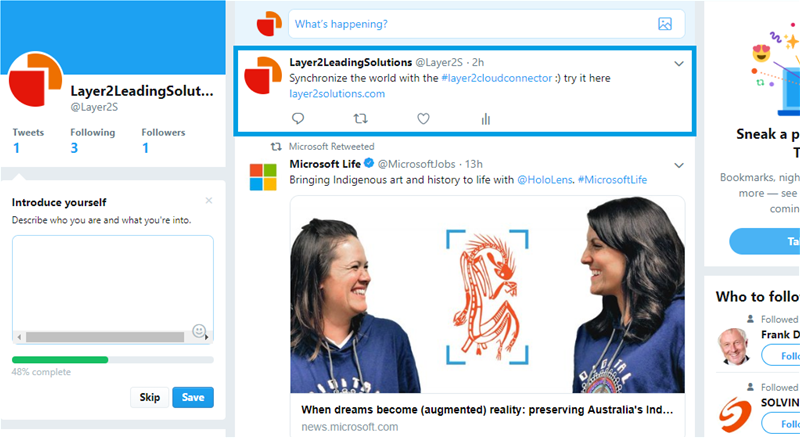
This will be the result in our SharePoint Online list after our initial successful synchronization:
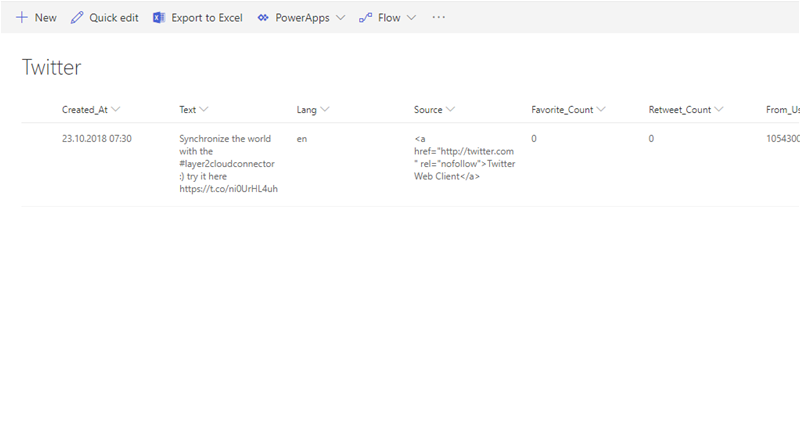
As far as tested, this connection supports uni-directional only.
To see all the available endpoint for Twitter, visit the API from Twitter.
When clicking on Preview Data, some browser versions are not supported. You can change the selected browser version for the Preview Data pop-up window adding or changing a specific registry key in Windows.
Open your registry editor and follow this path:
HKEY_CURRENT_USER\Software\Microsoft\Internet Explorer\Main\FeatureControl\FEATURE_BROWSER_EMULATION
Create a new DWORD (32bit) with the name mmc.exe and set the decimal value to 11001. Restart the Cloud Connector.
You can find more information about it here.
The connection to this system uses a custom authentication. The provider needs the running account connected to the backend service from the Cloud Connector.
Open services.msc and search for the Layer2 Cloud Connector Service. Right-click on it and go to Properties. Set your account with the password in the tab Log On. Restart the service.
NOTE: if you update your Layer2 Cloud Connector, this step must be repeated.
If you get the error "connection forcibly closed by remote host", you must change some registry keys in your machine. Please note that we recommend making registry changes only if you have proper experience in doing so. If you have no knowledge of editing the Windows registry, please ask your administrator.
Open the regedit.msc and create the DWORD-keys below in the paths:
1) HKEY_LOCAL_MACHINE\SOFTWARE\Microsoft\.NETFramework\v4.x.xxx
2) HKEY_LOCAL_MACHINE\SOFTWARE\WOW6432Node\Microsoft\.NETFramework\v4.x.xxx
Keys:
Type: DWORD
Name: SchUseStrongCrypto
Value: 1
Type: DWORD
Name: SystemDefaultTIsVersions
Value: 1
Restart the Layer2 Cloud Connector.